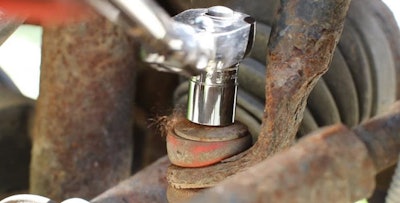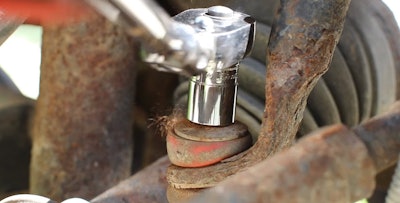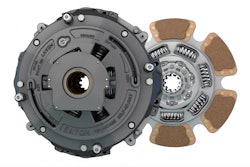
 Snap-on’s new FDX socket has a ledge or groove on the outer surface that makes it easier for the socket to be removed from the ratchet even with oily hands. The larger block numbers stamped on the sockets makes it easier to identify the size.
Snap-on’s new FDX socket has a ledge or groove on the outer surface that makes it easier for the socket to be removed from the ratchet even with oily hands. The larger block numbers stamped on the sockets makes it easier to identify the size.While you may never need a high-strength steel 5 ½-in. socket, specific jobs demand specific sockets and selection should not be taken lightly.
Anyone who’s ever cracked a socket or rounded off a nut or bolt with an ill-chosen socket knows too well the value of choosing the right tool for the job.
Sometimes while in a rush to fix things, a tech might grab the nearest 19mm socket, pop it on a ½-in. breaker bar and torque it with all he’s got. When that doesn’t work, he may slip a metal pipe over that bar for extra leverage and really crank on it.
Whether reaching for an impact gun, breaker bar or 3/8 in. ratchet, proper socket selection should come first. After all, it’s a direct link between a shop and a job well done.
For stubborn fasteners or for those where you’d like to utilize the speed of an impact gun, the experts at Snap-on recommend using an impact socket. They’re easy to spot. Unlike the more common chrome alloy socket, they’re black or grey in color and feature a thicker steel exterior that’s been heat-treated for extra strength.
Easy enough. But what about choosing between a six- or 12-point socket? Most impact sockets feature six contact points because most high torque fasteners are six-sided, or hex, nuts and bolts. But the market is changing.
“A 6-point (or single hex) Flank Drive socket is generally chosen to get a more secure fit on the fastener with less chance of rounding the fastener,” Snap-on says. “A 12-point (or double hex) Flank Drive socket is used primarily for 12-point fasteners, which are becoming more common, especially for head bolt fasteners. A 12-point socket might also be chosen because it is easier to engage the socket onto a fastener, since there is less rotation to initially engage the fastener as the socket has a corner every 30 degrees instead of 60 degrees.”
Getting to a fastener in a tight space under the hood can be a real challenge. That’s where wobblies, or swivel sockets, and extensions can definitely help. But there are some trade-offs.
“Impact swivel sockets and extensions are a must for getting into hard to reach places. However, there can be some torque loss when using an impact wrench,” Snap-on says. “Using swivel impact sockets and long extensions means the impact delivered must travel through multiple components that can dampen the blow of the impact and may limit energy transfer. This is due to torsional windup of a long extension (similar to torque sticks that are designed to limit torque transfer).”
Obviously, impact sockets can withstand great amounts of torsional pressure from an impact gun, but when should a tech call it quits on trying to remove a stubborn bolt or nut and opt for a different tactic?
According to Snap-on if a technician can’t break a bolt loose within about five seconds of impacting, they often choose to soak the fastener joint with lubricant or try heating the joint in an attempt to loosen the fastener, according to Snap-on.
The writer can still remember the first time I saw a torch being used to remove a stubborn nut. It made a huge difference. It doesn’t have to be a pricey oxy acetylene set-up either. Not too long ago, I used a common propane torch to remove starter mounting bolts on my pickup. Those jokers wouldn’t budge until I heated them up for a while and then used a ½-in. ratchet to turn them out. Just be cognizant of any nearby flammable material, such as wire insulation and fuel lines. In this case, the lines were located on the opposite side of the vehicle.
Of course, we had to ask Snap-on if socket misuse was a problem — not that I was ever guilty. Their response?
“Technicians should avoid using hand sockets on impact guns because thin-wall hand sockets are optimized for high-strength and could fracture during impact use. Impact sockets have thicker walls and are heat treated to optimize strength and toughness,” Snap-on says.
Seems like a no-brainer, but often times taking that extra moment or two to grab the right socket just seems like too much of a hassle. Then you come across headlines like “Beware exploding sockets” and it gets you thinking.
Granted, the company that published that safety tips article, Turbine Generator Maintenance, focuses on much larger fasteners and torque levels, but their warnings of how sockets have exploded like grenades and caused serious injury or death should be taken seriously at all levels of wrenching. Besides being mindful of socket torque limits, TGM suggests placing a pipe around the socket prior to use so that you’ve got a barrier in case the socket explodes. Again, we’re talking about severe torque levels that most techs will rarely encounter on a truck. But nonetheless it’s a good tip to keep in mind just in case.
On the issue of user friendliness, consider sockets with raised ridges or grip points that are easier to hold onto under greasy conditions. Some of my favorite sockets and extensions have this grip feature which makes it a lot easier to turn by hand when I don’t want to use a ratchet like when I’m first threading a bolt or want to remove it faster after initially loosening it with a ratchet. Also, as I’m getting older, I’m noticing how I’m leaning towards larger print everything, including large stamped numbers on sockets. But large print is also great in low-lit conditions when you’re heading back to the box and want to quickly snatch the right socket instead of fishing and poking through similar sizes.
Special thanks to Snap-on for their help on Socketology 101. Keep in mind that they’ve got plenty of socket options: shallow, mid-length, and deep Flank Drive sockets in both single hex and double hex; hand and impact Flank Drive sockets; hand and impact swivel Flank Drive sockets in both shallow and deep; and numerous specialty sockets for specific applications.
Having a large variety of tools allows techs to more carefully select the right tool for the job and get the job done more easily and faster.











